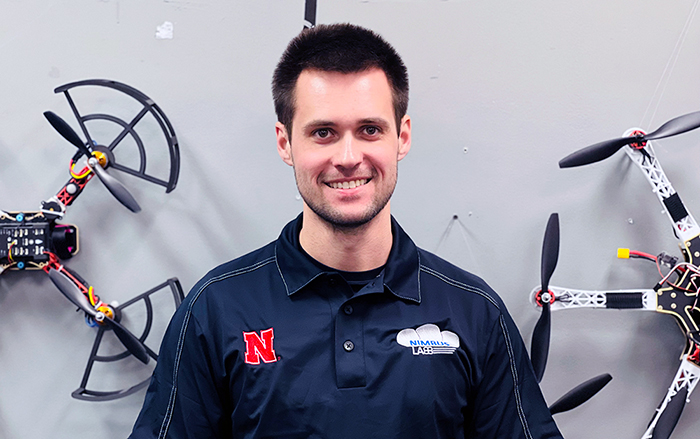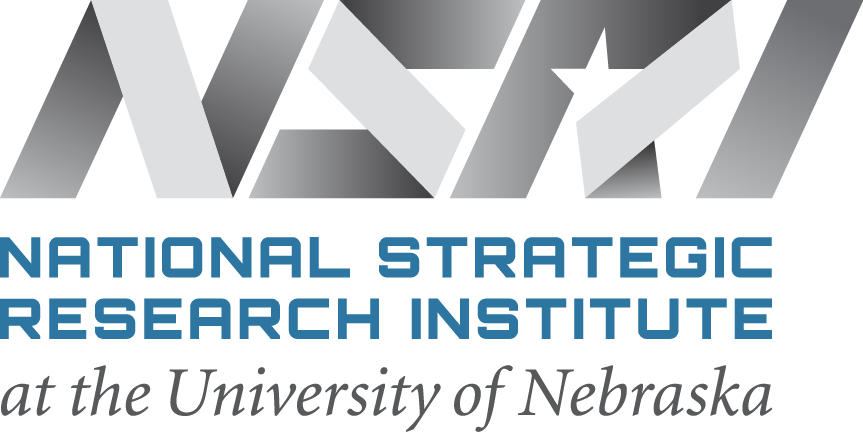
Grant Phillips is a second-year doctoral student in the School of Computing at the University of Nebraska–Lincoln. In 2020 he joined the UNL Nebraska Intelligent MoBile Unmanned Systems (NIMBUS) Lab as a doctoral student in computer engineering.
What is most interesting about the work with NSRI?
For the project I’m part of, I help design and test a platform for testing UAV swarm-control algorithms to be used in outdoor settings. The small-scale testing (three or fewer UAVs) is done at the NIMBUS Lab's netted outdoor facility on Nebraska Innovation Campus. The large-scale testing (4+ UAVs) is done at Roger's Memorial Farm.
There were very challenging problems of scaling from one to many robots working together simultaneously. Working with a single vehicle is more straightforward; if we focus our attention on maintaining it and monitoring its flights closely, we can often achieve approximately a 95 percent success rate. However, in a swarm, even if each vehicle is 95 percent reliable, there is only approximately a 60 percent chance all the robots in a swarm of ten UAVs will work correctly — just barely over half! Attempting to push reliability beyond that 95 percent level, the way we would with a single vehicle, can become very costly in time and dollars (i.e., purchasing the best hardware, and ensuring every component works before each flight).
To improve these numbers, without using all our resources in that manner, we track the vehicle’s sub-systems performance between flights, which helps identify parts that may be approaching their mean time-to-failure. In NIMBUS, we also emphasize robust and fault-tolerant software, meaning that if a component fails, we can safely disengage the vehicle from the mission or better yet, have it identify its own failure, recover and proceed with the mission (i.e., reboot its computer on its own).
These challenges don’t often show up in simulation, which is where much of the multi-agent research takes place. The challenge of managing several robots, both on the ground and in the air, has been a unique and exciting challenge, and we have made significant contributions in swarm management.

What would your peers find most fascinating?
Battery life on drones is very limited, so for swarm mission planners, time is everything! Under perfect conditions, we might get 20 minutes of flight from each swarm robot, and some of that time is spent simply flying to the mission area before the mission really begins.
To extend mission duration and create a more capable swarm, we conserve battery life by deploying the individual robots from a much larger "mothership." When the mothership is near the mission area, swarm robots are dropped from a custom dropping mechanism I designed and begin carrying out their mission.
It’s very exciting to watch, although it is a few minutes of terror for my team as we ensure all the robots safely deploy. Although we didn’t invent dropping drones, we are one of only a few groups that deploys swarms in this manner. The results are significant — an approximate 70 percent improvement in mission duration. This sort of improvement changes how our DOD collaborators think about mission design.
What have you learned?
I think the biggest lesson for swarm work is to automate as much as possible, as early as possible. This reduces the odds of problems developing during flight. I have developed several tools to improve regular testing and ensure safety of large teams of robots.
Why is this work meaningful to you?
Many UAV applications can contribute to surveillance, target acquisition and reconnaissance missions, and UAV swarms can scale the size of these missions. Additionally, swarms can be used for counter-UAS missions, package delivery, and search and rescue.
I have a personal belief that a lot of today’s problems can and should be solved with automation. The technology exists and has existed in some form for years. It seems that people and industry are slow to adopt it outside the engineering community.
The ideas and solutions I explore in the NIMBUS lab are not necessarily specific to UAVs but are applied to them. I think that, in time, the ideas and practices that push forward our UAVs in the lab will make their way into day-to-day life as we become more comfortable with automation.
Learn more about the NIMBUS Lab at nimbus.unl.edu.
###
About the National Strategic Research Institute
Through the National Strategic Research Institute at the University of Nebraska leading scientists deliver innovative national security research, technology, product and strategy development, training and exercises, and subject matter expertise to the Department of Defense and other federal agencies. One of only 15 DOD-designated University Affiliated Research Centers in the country, NSRI is sponsored by U.S. Strategic Command and works to ensure the United States’ safety and preparedness against increasingly sophisticated threats. Read about our mission.

